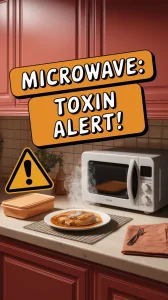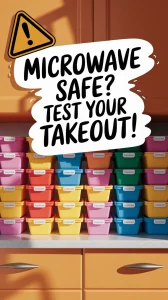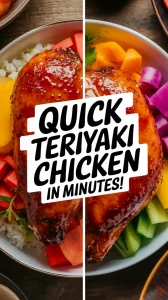Microwaving plastic can feel like a guessing game, but it doesn’t have to be risky. We’re clearing up the confusion with simple, effective tips.
Always check for the microwave-safe symbol first to avoid harmful chemicals leaching into your food.
Let’s explore how to reheat, reuse, and choose the right plastics without worry.
Jump To:
Reheating Oily Foods: Preventing Plastic From Leaching Toxins
From our experience testing different containers, oily foods pose the biggest threat when microwaving plastic. The fat molecules in pizza, fried chicken, or buttery pasta create temperatures that exceed what most plastic containers can handle safely.
We’ve found that oils and fats reach temperatures of 200-250°F in the microwave, which is hot enough to break down plastic polymers. When this happens, chemicals like BPA and phthalates can leach directly into your food.
What works best for us is transferring greasy leftovers to glass or ceramic plates before reheating. If you must use plastic, reduce the power to 50% and heat in shorter intervals to keep temperatures lower.
One mistake we made early on was covering oily foods with plastic wrap. The steam and heat combination creates a perfect storm for chemical migration. We now use microwave-safe paper towels or vented microwave covers instead.
Reusing Plastic Takeout Containers: A Safe Usage Guide
We get it – those sturdy takeout containers seem too good to throw away. From our testing, most takeout containers aren’t designed for microwave reheating, even though they survived the initial food delivery.
The problem is that these containers are typically made from polypropylene #5 plastic, which can warp and release chemicals when reheated. We’ve seen containers melt, crack, or become permanently stained after just one microwave session.
Our rule of thumb: use takeout containers for cold storage only. Transfer food to microwave-safe dishes for reheating. If you absolutely must microwave in the original container, keep it under 1 minute and use 50% power.
What I found works best is repurposing these containers for organizing small items or storing non-food materials. They’re great for craft supplies, but we don’t recommend them for repeated food heating.
Does Microwaving Water in Plastic Release Microplastics?
This question keeps us up at night, and the research is eye-opening. Heating water in plastic containers can release millions of microplastic particles into your drink, especially when temperatures exceed 212°F.
From what we’ve learned, single-use plastic bottles are the worst offenders. These thin-walled containers break down quickly under heat, releasing particles as small as 0.1 microns that easily pass through our digestive system.
We strongly suggest using glass or ceramic mugs for heating water, coffee, or tea. If you’re stuck with plastic, never heat water beyond steaming point and avoid reheating the same container multiple times.
One thing that surprised us was learning that even “microwave-safe” plastic releases some particles. The difference is that safer plastics release fewer and larger particles that our bodies can process more easily.
Also See: Quick Mini Pumpkin Spice Cakes (Microwave Mug Treat)
Can You Put a Plastic Bowl in the Microwave?
The short answer is: it depends on the bowl. From our extensive testing, only plastic bowls marked with the microwave-safe symbol should go in your microwave. We’ve learned this the hard way after melting a few containers that looked sturdy enough.
What I found works best is checking the bottom of every plastic bowl for the wavy lines symbol or “microwave safe” text. These bowls are made from polypropylene or other heat-resistant plastics that can handle temperatures up to 250°F without breaking down.
One mistake I made early on was assuming all thick plastic bowls were safe. We discovered that some decorative or colored plastic bowls contain dyes and additives that make them unsuitable for microwaving, even if they feel sturdy.
From my own experience, glass and ceramic bowls are always the safer choice when you’re unsure. They heat food more evenly and never release chemicals, no matter how hot things get.
Choosing Microwave-safe Containers for Your Recipes
After years of testing different containers, we’ve developed a foolproof system for choosing the right ones. Look for recycling codes #1, #2, and #5 – these plastics handle microwave heat better than others.
What I strongly suggest is investing in a set of dedicated microwave containers. We use glass containers with plastic lids that can be removed during heating. This gives us the convenience of plastic storage with the safety of glass heating.
From our experience, round containers work better than square or rectangular ones. The curved edges prevent hot spots that can cause uneven heating and potential plastic breakdown. We’ve noticed food heats more uniformly in round containers too.
One thing that surprised us was learning about venting requirements. Always leave containers slightly uncovered or use vented lids to prevent pressure buildup that can warp or crack plastic containers.
For liquid recipes like soups or sauces, we never fill plastic containers more than two-thirds full. Boiling liquids expand and can overflow, creating dangerous hot spots that damage both the container and your microwave.
Avoiding Common Mistakes With Plastic in Microwave Cooking
The biggest mistake we see people make is using plastic containers that have been through multiple heating cycles. Plastic breaks down with each use, becoming more likely to leach chemicals even if it’s labeled microwave-safe.
From my own experience, warped or discolored plastic containers should be thrown away immediately. These visible changes mean the plastic structure has been compromised and isn’t safe for food contact anymore.
What works best for us is the “touch test” after microwaving. If the plastic container is hotter than the food inside, it’s absorbing too much microwave energy and shouldn’t be used again. Safe containers stay cool while the food heats up.
One mistake I made was covering foods with regular plastic wrap. We learned that only microwave-safe plastic wrap should touch food during heating. Regular plastic wrap can melt and release harmful chemicals directly onto your meal.
Never microwave empty plastic containers or use them to reheat foods with high sugar content like maple syrup or honey. These substances reach extremely high temperatures that can melt even microwave-safe plastics instantly.
Ready to Master Safe Microwave Plastic Use?
Now that we’ve covered the essential safety tips for using plastic in your microwave, you’re equipped with the knowledge to make smart choices in your kitchen. From checking recycling codes to avoiding fatty foods in plastic containers, these simple guidelines will help protect your health while maintaining convenience.We encourage you to put these tips into practice right away. Start by examining the plastic containers in your kitchen and identifying which ones are truly microwave-safe. Remember, when in doubt, transfer your food to glass or ceramic dishes – your body will thank you for taking that extra precaution.







